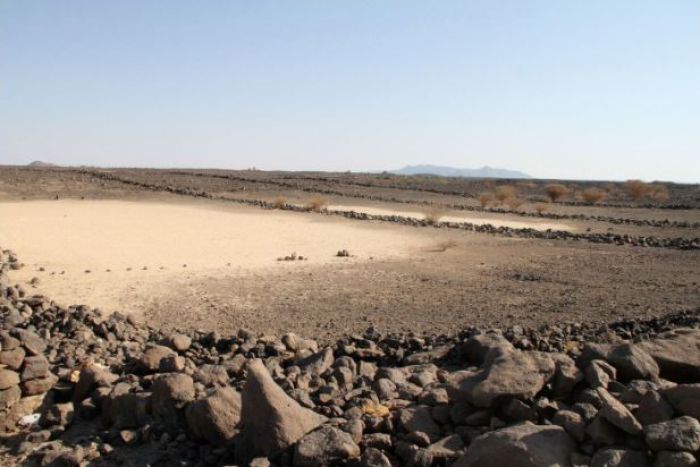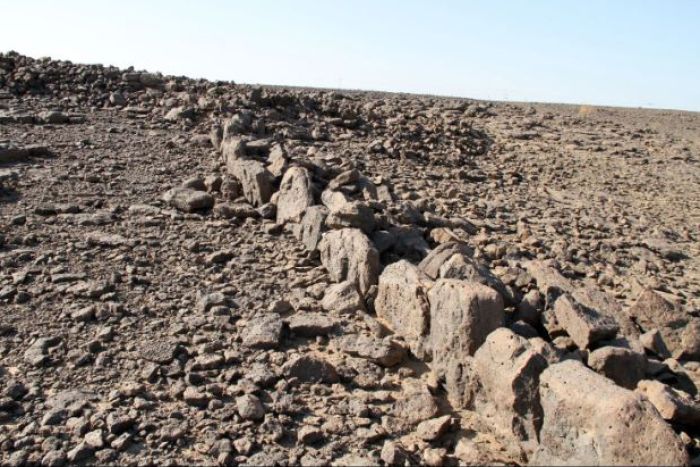It looks like you're using an Ad Blocker.
Please white-list or disable AboveTopSecret.com in your ad-blocking tool.
Thank you.
Some features of ATS will be disabled while you continue to use an ad-blocker.
13
share:
High-resolution images from Google Earth have led to the
discovery of hundreds of mysterious ancient structures scattered
across the desert in Saudi Arabia — by an archaeologist in Perth
who has never visited the area. David Kennedy, professor of
archaeology at the University of Western Australia, says the
man-made structures built from stone are between 2,000 and
9,000 years old. They are known as "gates" because their shape
resembles traditional farm gates, but some are up to 500 metres long.

These resemble the rock walls made by farmers here .
Every year they rake the fields to grow wheat in the sand .
The rocks line the edge of the fields , forming fences .
And every year , after harvest , the sand blows away , to reveal
.... more rocks !
Presumably , way back when , these areas weren't so arid .

www.abc.net.au...
Parton studied dried-up riverbeds in south-east Arabia.
Found in a quarry, the Al Sibetah site preserves the silt and
sediments from the bottom of the rivers, going back 160,000 years.
They found evidence of five wet phases, during which the rivers
flowed and silt was deposited. During the dry times, there was
little water flow and less silt was laid down. The first wet phase
happened between 160,000 and 150,000 years ago, and the most
recent was around 55,000 years ago.
www.bbc.com...
Is this evidence of farming from 50 , 000 years ago ?
edit on 25-10-2017 by radarloveguy because: xxx
a reply to: radarloveguy
What if they are Stargates? ATS member Skyfloating once made a beautiful thread that shows that Muslims believed that there are Seven Earths each with humans in there.
www.abovetopsecret.com...
What if they are Stargates? ATS member Skyfloating once made a beautiful thread that shows that Muslims believed that there are Seven Earths each with humans in there.
www.abovetopsecret.com...
edit on 10/25/2017 by starwarsisreal because: (no reason given)
originally posted by: starwarsisreal
a reply to: radarloveguy
What if they are Stargates? ATS member Skyfloating once made a beautiful thread that shows that Muslims believed that there are Seven Earths each with humans in there.
www.abovetopsecret.com...
I think farming is more realistic.
originally posted by: VelvetSplash
originally posted by: starwarsisreal
a reply to: radarloveguy
What if they are Stargates? ATS member Skyfloating once made a beautiful thread that shows that Muslims believed that there are Seven Earths each with humans in there.
www.abovetopsecret.com...
I think farming is more realistic.
Yeah but stargates are a lot more fun to talk about.
a reply to: VelvetSplash
Except 55,000 years ago there supposedly was no farming.
Interesting whatever they are.
Except 55,000 years ago there supposedly was no farming.
Interesting whatever they are.
originally posted by: radarloveguy
Parton studied dried-up riverbeds in south-east Arabia.
Found in a quarry, the Al Sibetah site preserves the silt and
sediments from the bottom of the rivers, going back 160,000 years.
They found evidence of five wet phases, during which the rivers
flowed and silt was deposited. During the dry times, there was
little water flow and less silt was laid down. The first wet phase
happened between 160,000 and 150,000 years ago, and the most
recent was around 55,000 years ago.
www.bbc.com...
Is this evidence of farming from 50 , 000 years ago ?
No, not evidence of farming and not evidence that these are as old as 50,000 years. Farming makes changes on the land that are pretty noticeable.
Your two stories are two separate things and are not linked, I'm afraid. The "gates" could be as young as 200 years old.
originally posted by: Byrd
originally posted by: radarloveguy
Parton studied dried-up riverbeds in south-east Arabia.
Found in a quarry, the Al Sibetah site preserves the silt and
sediments from the bottom of the rivers, going back 160,000 years.
They found evidence of five wet phases, during which the rivers
flowed and silt was deposited. During the dry times, there was
little water flow and less silt was laid down. The first wet phase
happened between 160,000 and 150,000 years ago, and the most
recent was around 55,000 years ago.
www.bbc.com...
Is this evidence of farming from 50 , 000 years ago ?
No, not evidence of farming and not evidence that these are as old as 50,000 years. Farming makes changes on the land that are pretty noticeable.
Your two stories are two separate things and are not linked, I'm afraid. The "gates" could be as young as 200 years old.
As you say , farming leaves evidence ,.
in this case rock fences ,.
And who ? , in their right mind would be out there
200 years ago , piling up rocks ?
Ergo , fields from a previous time , ... one that had rainfall .and some dirt ...
edit on 28-10-2017 by radarloveguy because: xxx
originally posted by: radarloveguy
originally posted by: Byrd
originally posted by: radarloveguy
Parton studied dried-up riverbeds in south-east Arabia.
Found in a quarry, the Al Sibetah site preserves the silt and
sediments from the bottom of the rivers, going back 160,000 years.
They found evidence of five wet phases, during which the rivers
flowed and silt was deposited. During the dry times, there was
little water flow and less silt was laid down. The first wet phase
happened between 160,000 and 150,000 years ago, and the most
recent was around 55,000 years ago.
www.bbc.com...
Is this evidence of farming from 50 , 000 years ago ?
No, not evidence of farming and not evidence that these are as old as 50,000 years. Farming makes changes on the land that are pretty noticeable.
Your two stories are two separate things and are not linked, I'm afraid. The "gates" could be as young as 200 years old.
As you say , farming leaves evidence ,.
in this case rock fences ,.
And who ? , in their right mind would be out there
200 years ago , piling up rocks ?
Ergo , fields from a previous time , ... one that had rainfall .and some dirt ...
Fences or structures like that could mean a lot of things (including pens for animals.) As the original report says, there's no real evidence that it's farming (the bit about lake bottoms is from another site and a different era.) They could also be fortifications or temple areas or something else entirely. A good dig in the area would tell more about their purpose.
And there's dirt there and rainfall (but not a lot of rain.)
new topics
-
Nvm
General Chit Chat: 1 hours ago -
OK this is sad but very strange stuff
Paranormal Studies: 7 hours ago -
Islam And A Book Of Lies
Religion, Faith, And Theology: 8 hours ago -
Sorry to disappoint you but...
US Political Madness: 10 hours ago
top topics
-
Sorry to disappoint you but...
US Political Madness: 10 hours ago, 13 flags -
Watch as a 12 million years old Crab Emerges from a Rock
Ancient & Lost Civilizations: 15 hours ago, 10 flags -
OK this is sad but very strange stuff
Paranormal Studies: 7 hours ago, 6 flags -
Islam And A Book Of Lies
Religion, Faith, And Theology: 8 hours ago, 5 flags -
Nvm
General Chit Chat: 1 hours ago, 1 flags
active topics
-
Volcano Watch 2025
Fragile Earth • 7 • : Cracka -
Meta Llama local AI system is scary good
Science & Technology • 40 • : glend -
The Acronym Game .. Pt.4
General Chit Chat • 1035 • : bally001 -
Joe Biden gives the USA's Highest Civilian Honor Award to Hillary Clinton and George Soros.
US Political Madness • 49 • : ADVISOR -
Nvm
General Chit Chat • 1 • : Mantiss2021 -
Post A Funny (T&C Friendly) Pic Part IV: The LOL awakens!
General Chit Chat • 7993 • : Cymru -
ILLUMINATION: Dimensions / Degrees – Da Vincis Last Supper And The Philosophers Stone
Secret Societies • 6 • : Compendium -
Sorry to disappoint you but...
US Political Madness • 15 • : Flyingclaydisk -
Musk calls on King Charles III to dissolve Parliament over Oldham sex grooming gangs
Mainstream News • 180 • : Freeborn -
Islam And A Book Of Lies
Religion, Faith, And Theology • 3 • : nugget1
13
